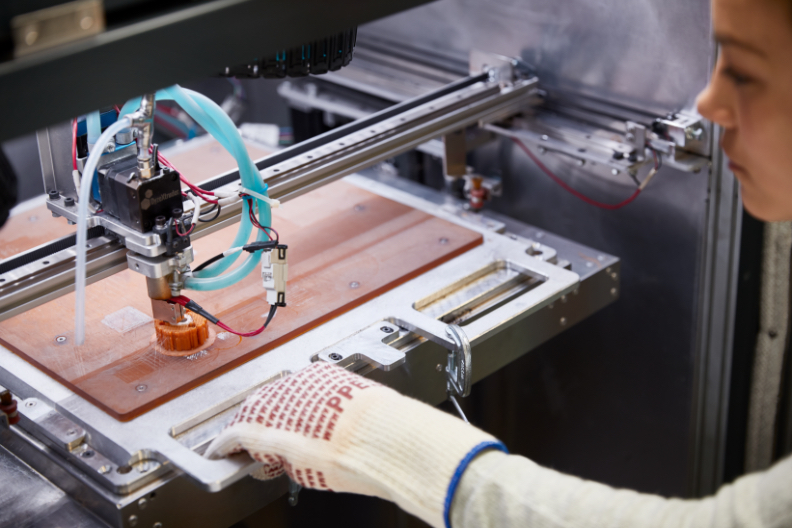How additive manufacturing is advancing jigs and fixtures
3D printing's advantages for jig and fixture production continue to drive rapid adoption.
Laying down a pattern for growth
Jig and fixture production has become one of the most widely employed applications of additive manufacturing, thanks to its proven advantages over traditional production methods. However, it's not a mature market, and industry observers predict strong continued adoption within the mainstay of assembly-line production and into ancillary application across a diverse range of industries.
What’s in a jig?
A jig is a supporting piece used to ensure that work with a tool, often cutting or drilling, is executed consistently, cleanly, and efficiently. A drill jig, for example, is used to guide a drill bit on the receiving part for consistent results.
Fixtures are used to orient and support a part for assembly. For example, an inspection fixture confirms the alignment of the Mercedes badge on the hood of the finished car, ensuring that it’s placed perfectly centered and square.

The AM advantage for jig and fixture production
Jigs and fixtures improve accuracy, consistency, and productivity, making them a central, well, fixture on modern assembly lines. Traditionally, a jig or fixture might be welded by hand, or CNC machined either, on-premises or by an outside vendor.
Machined, hand-crafted parts are expensive and usually come with long lead times. A 3D printer resolves those issues and adds another advantage: the ability to iterate and optimize a part.
In practice, most jigs and fixtures are of hybrid construction."When you're using standard components together with additive, in a hybrid, that's impactful," said Brandon Cernohous, Research and Development Manager, Infinite Material Solutions. "You reap the benefits of precision and strength found in traditional materials with the speed and flexibility of a printed part."
Jaw-dropping savings of time and part cost are par for the course in case studies on AM use for jig and fixture production and are reason enough to account for its continued adoption.
In the long run though, the speed and agility an AM solution offers could prove to be even more valuable than cost savings, enabling a faster design to production cycle — and the difference between being first to market and an also-ran.

Hey, who put that software into the vise?
Integration of jig and tool production into DFAM (design for additive manufacturing) workflows is already on software maker nTopology’s roadmap. As reported by industry publication Fabaloo, “The FDM Assembly Fixture Generator automates the design of jigs and fixtures and enables engineers to quickly turn a part file into a ready-to-print fixture with a simple drag-and-drop.”
Jig and fixture production then can be thought of as one more application that slots right into a DFAM approach.
If you see a robot at work in a production setting, chances are that the "hand" at the end of the robot's arm is a printed part, a part analogous to a screwdriver bit and one that can be quickly modified or swapped as needs change.

The right jig for the job
As build and support material options have expanded, so too have the application options for jigs and fixtures. To choose the right build material, strength, chemical, and heat resistance requirements need to be considered. As explained by Essentium, various materials lend themselves to work best in certain applications and for the creation of specific products.
| Material Category | Characteristics | Examples | Ideal use |
|---|---|---|---|
| General Purpose | Durable and affordable Offers stiffness and impact resistance |
PLA | Fixtures, guides, gauges, and handheld tools |
| High strength | Impact, chemical, and abrasion resistant. Excellent tensile strength, stiffness. |
PA, PA-CF, PC, PC ABS | Automotive parts and low-friction bearings and gears |
| Flexible | Good elasticity with strength and tear resistance | TPU 95A, TPU 80A, TPE | Soft robotic grips, masking tools |
| High-temperature engineering |
Strength, high temperature compatibility, reduced moisture absorption | PEEK, high-temperature nylons (HTN), nylon CF, nylon glass fiber | Engine, exhausts, other fixtures used in harsh environments |
| ESD-safe | Electrostatically dissipative | ESD variance of: PEKK ABS, PEKK, nylon CF | Electrical components or circuit boards Print tools for environments that pose a high combustion risk |
Support materials, including water-soluble options such as AquaSys®120 and AquaSys® 180, can further expand engineering and design possibilities because they don't require sanding or grinding for removal. AquaSys 180 is also compatible with high-temperature thermoplastics, such as PEEK, PEKK, PEI, and PPSU.
From breaking the sound barrier to the speed of light — jigs are building the future
Aviation startup Boom Supersonic rolled out its XB-1 aircraft last October and now has its first order, from industry heavyweight United Airlines, bringing us one step closer to the return of commercial supersonic flight. Naturally, the suite of technologies employed by the Denver-based company included AM.
As described in this blog post, Boom’s team printed more than 550 jigs, drill blocks overnight, demonstrating the speed and efficiency of AM technology.
Jigs and fixtures are usually seen as an assembly line application, but in an article on Fabbaloo, Kerry Stevenson describes a visit to an internet exchange facility that has more than a dozen 3D printers on-site used to print fixtures that organize and route the dizzying array of cabling in use. A facility like this does frequent add-ins, equipment updates, and swaps, making organization and easy access an important time saver.
Examples like these show just how wide AM's utility can be — and how it expands the definition of what's expected (and possible) in a business category.

Read more about 3D printing capabilities in the article, "Additive manufacturing: Open vs. closed systems."